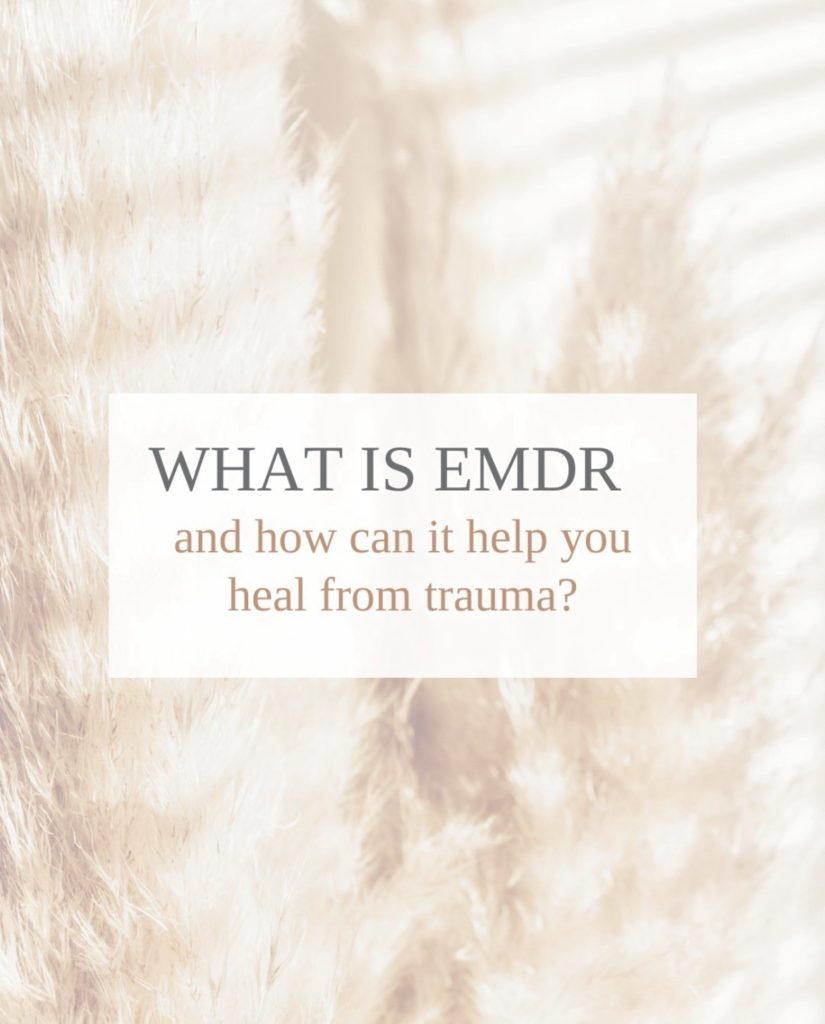What Is EMDR Therapy?
EMDR (Eye Movement Desensitisation and Reprocessing) is a psychological therapy that was developed by Francine Shapiro in 1987, and is an internationally recognised treatment for trauma, as well as other psychological difficulties, such as anxiety disorders and depression.
EMDR is used to alleviate current symptoms and problems that may be linked back to difficult past experiences. We know that experiences that are extremely stressful can become stuck and can negatively affect you for a long time. Examples of this may look like being humiliated at school in front of your class, someone you love being harsh or unkind to you a lot of the time, or being involved in an assault.
These situations can affect the way you feel about yourself, other people and the world in general. Given that how you feel influences how you think and how you live your life, it’s important to overcome any unprocessed experiences so that ultimately, you feel better in the present. EMDR can be used to help you to process these experiences and the impact it has on you on an emotional and physical level.
How Are Disturbing Memories Stored In The Brain?
Research shows us that stressful experiences can become stuck in the brain and the nervous system, leading to an array of current physical symptoms associated with anxiety and low mood. Quite often, you can walk around day-to-day experiencing physical symptoms that can be linked back to previous life experiences that are unprocessed.
Let's imagine you were bullied at school about how you looked and started to develop the belief "I am unattractive." This belief would have been reinforced each time someone made a negative comment about your appearance.
Then, more recently, you notice someone at work makes an innocent comment about your appearance, and without realising it, your brain and body react just as you felt at the time you were bullied back in school.
From an EMDR perspective, this reaction is because your brain is interpreting something about the current situation in a similar way to the memories of you being bullied at school. Memories are stored in the brain by association, and this is the reason that current situations can trigger old material in the brain.
At the time of the bullying, the situation may have been so overwhelming for you that your brain wasn't able to process that experience in its usual way. The consequence of that is the experience is what we call "dysfunctionally stored" in the brain, which means that the memory is stored in it's original format, along with all the images, feelings, beliefs, physical sensations and sensory information that was there at the time it happened.
As humans, we draw upon our experiences and beliefs about ourselves to make sense of the world, so if you believe you are unattractive based on being bullied, you'd be more likely to avoid relationships or be anxious about dating in the here and now.
How Does EMDR Work?
EMDR uses what is known as bilateral stimulation (typically fast eye movements) to replicate the Rapid Eye Movement (REM) sleep phase. One of the theories about why rapid eye movements helps us heal from trauma is that the REM sleep phase helps our brains to process the events and experiences of the day, so EMDR is doing what your body naturally does when you are asleep, but you are completely awake and in control throughout the process. There are other types of bilateral stimulation such as body tapping, listening to auditory tones, or holding hand held buzzers that vibrate alternately in your hands.
Bilateral stimulation stimulates the right and left hemispheres of the brain, which kick starts your brains natural process for healing. Research shows that bilateral stimulation takes the vividness and emotional intensity out of distressing experiences.
Using the example above, EMDR would work by recalling the earliest memory you have of feeling unattractive and to think of a picture that represents the worst part of that experience. You would then be asked how that experience makes you feel emotionally and in your body now, when you recall it. You would also be asked what you would prefer to believe about yourself when recalling the stressful event.
You would then start the bilateral stimulation and your brain will do the work, working through each of the stuck parts until the memory is completely processed and your beliefs have changed on an emotional level.
The 8 Phases Of EMDR
Phase 1 – History Taking
This phase is all about learning more about you and your life story. We would look at from birth to the present day and identify both positive and negative life experiences. This phase is also about working out together whether EMDR would be an effective treatment for you.
Phase 2 – Preparation and Resourcing
This phase is all about getting you resourced and learning how to self-soothe inside and outside the sessions. This phase is vital, especially because when you work through stressful life experiences, it often can bring up negative feelings, so being well-resourced means you will be more able to stay within your window of tolerance.
Phase 3 – Activating The Memory
In phase 3, we will be deciding what memory we are working on and your therapist will ask you questions about it and what it brings up for you now. Doing this allows the memory to be activated, ready to be processed in the next phase. This phase is relatively short so shouldn’t take long at all.
Phase 4 – Desensitisation
Phase 4 is the part that everyone associates with EMDR, the “eye movement” phase. Phase 4 is when you are using bilateral stimulation to help the brain process the memory and associated material. Bilateral stimulation is shown to take the vividness and intensity out of the memory. Once you no longer feel emotionally distressed when you recall the memory, the desensitisation phase is complete.
During this phase, you may notice physical sensations, emotions, images, beliefs and other sensory details relating to the experience you are working on that have remained stuck. This part can often feel overwhelming but is necessary for the processing and healing to occur.
Phase 5 – Installing a Positive Belief
This phase is about attaching a positive word or statement about yourself with the memory. An example might be something like, “I am safe now,” or “I am good enough.” We would strengthen and install this new positive statement using bilateral stimulation until you believe the statement on an emotional level.
Phase 6 – Body Scan
Have you ever heard that the body keeps the score? This basically means that often the brain can process difficult experiences but the body doesn't catch up,tem, so the body scan is about checking to see if there is any physical disturbance left in the body associated with the memory being worked on. If there is, we would notice it and use bilateral stimulation to process it until there is no longer any physical sensations or discomfort left associated with the target memory.
Phase 7 – Closure
The closure phase is about closing the session and often practicing together a self-soothing strategy you learnt in phase 2 to ensure you aren’t leaving the session feeling too emotionally charged.
Phase 8 – Re-evaluation
This last phase is carried out when you come back to your next EMDR session. We would ask you how you have felt since the last appointment, and we would review what triggers have come up for you. What we tend to notice is that after EMDR, your body and emotions do not react in such an intense way, and you respond to old triggers differently.
Next, you would re-rate your emotional distress when you think about the memory, and whether any other associated material has come to light that we need to process. If there is, we would go back to phase 3-7 to process it. If not, the EMDR process is complete for that particular memory.
What If The Experience Wasn't "Traumatic?"
It's worth noting that the traumatic event(s) don't need to be something that is completely catastrophic in order for EMDR to be successful. Lots of people still struggle with the word trauma, and I've had clients say to me, "but it's not exactly a trauma is it, being bullied at school." My response is always the same, the only person that gets to decide if something is traumatic is the person who experienced the event. It's not your fault how your brain processes things, so even though it may on the face of it sound harmless, if the experience was enough to overwhelm your brain and nervous system so much that it wasn't processed properly, it is suitable for EMDR. Read Trauma - It's Not What You Think It Is for more information.
How Effective Is EMDR?
EMDR is a NICE approved psychological treatment for Post Traumatic Stress Disorder, and more evidence is showing that it is effective for other conditions such as anxiety and depression. NICE stands for the National Institute of Clinical Excellence and recommends the best treatment for both physical and psychological problems. NICE approved treatments are evidence-based, tried and tested, and effective, which is why they are recommended for use because their effectiveness is backed up by science and clinical research and trails.
What Problems Can EMDR Treat?
EMDR was initially used to treat Post Traumatic Stress Disorder (PTSD), but there is a growing evidence base to show its effectiveness in treating the following difficulties:
- Phobias
- Generalised Anxiety
- OCD
- Being a victim of crime
- Grief/loss
- Depression
- Perfectionism
- Body Image Issues
- Addictions
- Sexual assault
- Accidents
- Performance Anxiety
- Relationship Issues and Domestic Violence
- Childhood Trauma
- Perinatal Trauma
Can I Have EMDR If I Am Pregnant?
Yes! There are lots of myths about that say EMDR may not be safe to use if you are pregnant, however, there is currently no research at all that confirms this. In fact, what research shows is pregnant clients who receive EMDR Therapy experience decreased distress and PTSD symptoms, decreased fears of childbirth, less intrusive thoughts, and an overall increase in confidence about their upcoming delivery (Baas et al, 2022).
If you are pregnant and experiencing intense emotional distress, EMDR can actually help to reduce this distress. I would always recommend having a chat with an EMDR Therapist about your individual circumstances before making a decision. If you wanted to chat further about whether EMDR is suitable for you, book in your FREE consultation with me and we can chat more.
How Can I Access EMDR?
Your local Talking Therapies Service may offer EMDR on the NHS, however, some areas haven’t got the funding for it, meaning you’d need to fund your treatment privately. It’s worth getting in touch with your local Talking Therapies Service to see if EMDR is available with them.
If you have private medical insurance, you can ask them to see if you are covered for EMDR Therapy and have your treatment funded that way. I am a registered Psychotherapist with AXA, Bupa, and Nuffield Health, so if you are covered by them, please get in touch with me and we can arrange some EMDR for you.
If you don't have insurance but still want to have private EMDR, you can self-fund your sessions.
To summarise, EMDR is an effective and evidence-based treatment for emotional distress and is growing in popularity. It may or may not be available on the NHS, depending on where abouts in the UK you live. I find it so exciting using EMDR in my practice and I love to see how it benefits my clients. EMDR fascinates me and my clients by how it works!
Useful Links:
Hold The Mother Podcast Episode 8: What Is EMDR Therapy?
Can Childhood Adversity Cause Anxiety?
How Does EMDR Work In The Brain Video



